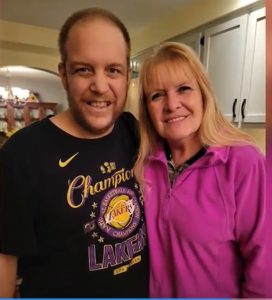All in the Family
- When Todd Cerimeli from Poland, Ohio found out he may need a stem cell transplant from a blood relative, his adoptive mother, Brenda Popa, started the search for his birth mother.
- Popa located Cerimeli’s birth mother, who lived just five miles away. Cerimeli learned he has two sisters and two brothers who could be a match for his transplant.
- A stem-cell transplant is used to treat blood cancers, such as acute myeloid leukemia (AML) and lymphoma, as well as multiple myeloma and certain blood or immune-system disorders.
That’s how Todd Cerimeli from Poland, Ohio describes his quest to find his birth mother as he undergoes treatment for cancer.
Read More
In a miraculous turn, Barb Drabiski lived just 4.5 miles down the road in Struthers, Ohio. She gave Cerimeli up for adoption when she was 15 years old.
Ceremeli’s adoptive mother Popa says they believe it was divine intervention.
“It was absolutely a God thing,” Popa said. “We have no doubts about that.”
And, as luck would have it, Cerimeli does indeed have siblings — two from his birth mother and two from his birth father.
And the good news didn’t stop there.
At a recent doctor visit, doctors said Cerimeli’s health was improving and put the bone marrow transplant on hold.
What is a Stem Cell Transplant?
A stem cell transplant is used to treat blood cancers, such as acute myeloid leukemia (AML) and lymphoma, as well as multiple myeloma and certain blood or immune-system disorders. When the transplant uses healthy blood-forming cells (stem cells) from a donor, the procedure is called an allogeneic stem-cell transplant.
“We don’t believe that chemotherapy, for the majority of leukemias, is sufficient in order to cure patients of their disease, forever,” says Dr. Caitlin Costello, hematologist-oncologist at UC San Diego Health. “And so a transplant is an opportunity to do that – cure patients with leukemia.”
After the patient’s own stem cells have been destroyed by high doses of chemotherapy or radiation, they are replaced with healthy stem cells from a donor. (In a variation on this procedure, an autologous stem cell transplant, the patient’s own stem cells are used.)
What acute myeloid leukemia patients should expect from a bone marrow transplant
Preparing for a Stem Cell Transplant
Patients will undergo testing to determine the strength of their heart, lungs, liver, and, kidneys, says Dr. Costello.
“And while you are going through this, your donor, who has not been identified, is being searched for,” says Dr. Costello.
A sibling donor is ideal, says Dr. Costello. Siblings have a 1 in 4 chance of matching. A close relative may also be a potential match. When the donor is an identical twin, the procedure is known as a syngeneic stem-cell transplant, and offers perfect genetic match.
Donor cells can also come from an unrelated donor who is genetically similar to the patient.
“If a sibling is not a match or is unavailable, we’ll be looking for an unrelated donor in a world-wide registry. So while you’re undergoing your testing, your transplant doctor is identifying a donor who would be a good option for you,” says Dr. Costello.
Preparing for a stem cell transplant
Learn more about SurvivorNet's rigorous medical review process.


